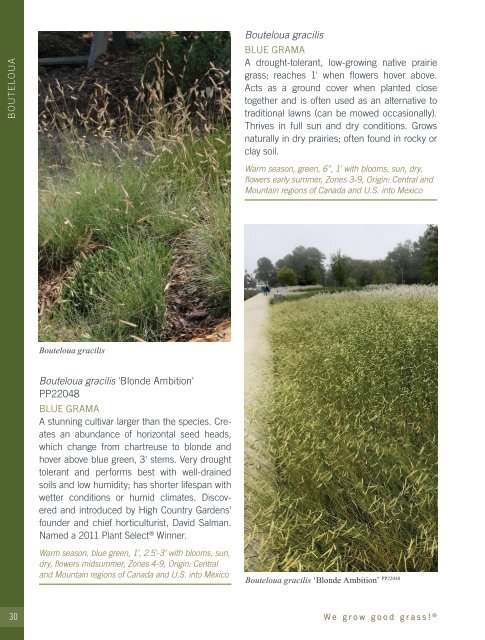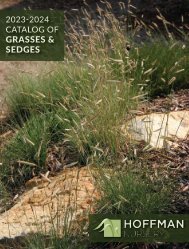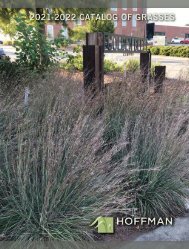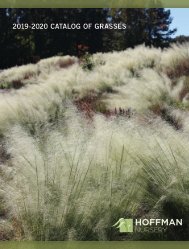2022-2023 Hoffman Nursery Catalog of Grasses & Sedges
You also want an ePaper? Increase the reach of your titles
YUMPU automatically turns print PDFs into web optimized ePapers that Google loves.
BOUTELOUA<br />
Bouteloua gracilis<br />
BLUE GRAMA<br />
A drought-tolerant, low-growing native prairie<br />
grass; reaches 1' when flowers hover above.<br />
Acts as a ground cover when planted close<br />
together and is <strong>of</strong>ten used as an alternative to<br />
traditional lawns (can be mowed occasionally).<br />
Thrives in full sun and dry conditions. Grows<br />
naturally in dry prairies; <strong>of</strong>ten found in rocky or<br />
clay soil.<br />
Warm season, green, 6”, 1’ with blooms, sun, dry,<br />
flowers early summer, Zones 3-9, Origin: Central and<br />
Mountain regions <strong>of</strong> Canada and U.S. into Mexico<br />
CALAMAGROSTIS<br />
Calamagrostis comes from the Greek kalamsos (reed) and agrostis (a kind <strong>of</strong> grass), hence the<br />
common name "reed grass". Found in Europe, northern Asia, and Central and North America, the<br />
genus includes roughly 250 species. Our selections are anchored by best-selling C. x acutiflora<br />
'Karl Foerster', an interspecific hybrid named for the eminent German plantsman.<br />
Calamagrostis brachytricha<br />
KOREAN FEATHER REED GRASS<br />
One <strong>of</strong> the few ornamental grasses that blooms<br />
in partial shade. A beautiful specimen and<br />
showy in masses with its pink, feathery plumes.<br />
Grows in a 3', fountain-like mound. In full sun,<br />
does best with sufficient moisture. Botanical<br />
sources suggest this plant is best included<br />
under C. arundinacea, a variable, wide-ranging<br />
species. Plantsman Cassian Schmidt proposes<br />
designating it C. arundinacea 'Richard Lighty' to<br />
distinguish it from other variants and to honor Dr.<br />
Lighty who selected it. Until the name is more<br />
widely used, we’ll leave it as is.<br />
CALAMAGROSTIS<br />
Warm season, green, 3’, 4’ with blooms, sun-shade,<br />
dry-moist, flowers early fall, Zones 4-9, Origin: East<br />
Asia<br />
Bouteloua gracilis<br />
Bouteloua gracilis 'Blonde Ambition'<br />
PP22048<br />
BLUE GRAMA<br />
A stunning cultivar larger than the species. Creates<br />
an abundance <strong>of</strong> horizontal seed heads,<br />
which change from chartreuse to blonde and<br />
hover above blue green, 3' stems. Very drought<br />
tolerant and performs best with well-drained<br />
soils and low humidity; has shorter lifespan with<br />
wetter conditions or humid climates. Discovered<br />
and introduced by High Country Gardens’<br />
founder and chief horticulturist, David Salman.<br />
Named a 2011 Plant Select ® Winner.<br />
Warm season, blue green, 1’, 2.5’-3’ with blooms, sun,<br />
dry, flowers midsummer, Zones 4-9, Origin: Central<br />
and Mountain regions <strong>of</strong> Canada and U.S. into Mexico<br />
Bouteloua gracilis ‘Blonde Ambition’ PP22048<br />
Calamagrostis brachytricha<br />
Calamagrostis x acutiflora 'Avalanche'<br />
VARIEGATED FEATHER REED GRASS<br />
A form <strong>of</strong> C. x acutiflora 'Karl Foerster' with<br />
vivid variegation: deep-green edges and white<br />
centers. Grows in a neat clump through early<br />
summer, then silver plumes shoot above. A coolseason<br />
grass, it seems to be stable in the summer<br />
heat at our nursery. Mix with perennials or<br />
plant in masses. Discovered by plantsman Steve<br />
Schmidt.<br />
Cool season, green-white variegated, 2’, 5’ with<br />
blooms, sun, average-moist, flowers late spring,<br />
Zones 4-8, Origin: Europe<br />
Calamagrostis x acutiflora ‘Avalanche’<br />
30 We grow good grass! ® 1-800-203-8590 h<strong>of</strong>fmannursery.com<br />
31








